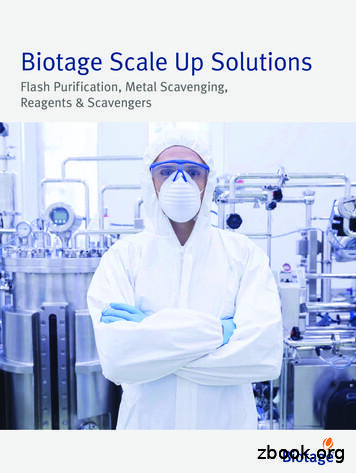Purification Of DNA Chapter 3 - Linköping University
Purification of DNAChapter 3Different types of DNA Total DNA Plasmid DNA Bacteriophage DNAOften.Separate chromosomal DNA fromplasmid/phage DNA
Purification of DNAFig 3.1, s26
1 OD 0.8x109 cells/mlFig 3.2 Sid 27
Fig 3.3 Sid 28
Preparation of cellextraktFig 3.4 Sid 28
Two ways to purify DNAFig 3.5 Sid 29
Phenolextraktion, det ”old” way topurify DNAFig 3.6 Sid 30
Column ChromatographyFig 3.7 Sid 31
Precipating DNA, EthanolprecipitationRecept:1vol prov av DNA2vol 96% EtOH1/10 vol 3M NaAcetatLåt stå i -80 frysen 30 minCentrifugeraOBS svårt att se pellet!!!Fig 3.8 Sid 32
DNA purification with silicaparticles/columnFig 3.10 Sid 34
Preparation of lysateFig 3.11 Sid 35
Conformations of DNAFig 3.12 Sid 36
Alkaline denaturationFig 3.13 Sid 37
CsCl density gradient centrifugationFig 3.14 Sid 37
Detection of DNAFig 3.15 Sid 38
Purification of plasmid DNA withEtBr CsCl density gradientcentrifugationFig 3.16 Sid 38
Plasmid amplificationFig 3.17 Sid 39
Purification of phage suspensionsFig 3.18 Sid 40
Induction of lysogenic phagesFig 3.19 Sid 41
To obtain high yieldFig 3.20 Sid 41
Precipitation of phages with PEGFig 3.21 Sid 42
Preparation of ss-DNA from M13Fig 3.23 Sid 43
Manipulation of DNAChapter 4Different types of enzymes: NucleasesLigasesPolymerasesModifying enzymes
NucleaserFig 4.1 Sid 47
NucleaserFig 4.2 Sid 48
NucleaserFig 4.3 Sid 48
DNA ligase reactionFig 4.4 Sid 48
DNA polymerase reactionFig 4.5 Sid 49
Modifying enzymesFig:4.6Sid 50
Fig:4.7Sid 51
Restriction enzymesFig:4.8,Sid 52
Cleavage pattern, sticky-, bluntendsFig:4.9 Sid 54
Restrictionsmap λ-fagFig:4.10Sid 55
How to find suitable restriction sitesin a fragmentUse NEB cutter:http://tools.neb.com/NEBcutter2/
Restriction digestFig:4.11, Sid 55
ElectrophoresisFig:4.12, Sid 57
Visualisation with EtBr(alternatively SyBrsafe)Fig:4.13, 4.14, Sid 58, 59
Restrictions mapFig:4.15, Sid 60
Restriction mapFig:4.16, Sid 62
The influence of DNA size onmigration rateFig:4.17, Sid 62
Ligation, the most critical step ingene cloningFig:4.19, Sid 63
LigationFig:4.20, Sid 64
Linkers for ligationFig:4.21, Sid 65
Linkers for ligationFig:4.22, Sid 66
Example of problem with linkers!Fig:4.23, Sid 66
Fig:4.24, Sid 67
AdaptorsFig:4.25, Sid 68
Fig:4.26, Sid 68
Blunt end ligation withtopoisomerasFig:4.27, Sid 69
Blunt end ligation withtopoisomerasFig:4.28, Sid 70
Introduction of DNA into living cellsTerms: Transformation Transfection Competent cells Identification of recombinants
Production of large amount of DNAFig:5.1Sid 73
Fig:5.2, Sid 73
Transformation with competentcells (chemically modified)Fig:5.3, Sid 75
Selection of plasmidsFig:5.4, Sid 76
phenotype expressionFig:5.5, Sid 76
Insertion inactivationFig:5.6, 5.7, Sid 77
Fig:5.8, Sid 78
Cloning in pUC8 (lac Z gen)Fig:5.9, Sid 79
Insertion inactivationFig:5.10, Sid 80
In vitro packagingFig:5.11, Sid 82
Bacteriophage plaquesFig:5.12, Sid 83
Fig:5.13, Sid 84
centrifugation Fig 3.16 Sid 38. Plasmid amplification Fig 3.17 Sid 39. Purification of phage suspensions Fig 3.18 Sid 40. Induction of lysogenic phages . Fig 3.21 Sid 42. Preparation of ss-DNA from M13 Fig 3.23 Sid 43. Manipulation of DNA Chapter 4 Different types of enzymes: Nucleases Ligases Polymerases Modifying enzymes .
Magnetic beads for DNA purification 9 Genomic DNA purification kits 10 Genomic DNA extraction 16 Genotyping—pharmacogenomics studies 17 Plant genomic DNA isolation kits 18 Viral genomic DNA purification kits 20 Genomic DNA from saliva 21 Complete purification system for nucleic acids
Part One: Heir of Ash Chapter 1 Chapter 2 Chapter 3 Chapter 4 Chapter 5 Chapter 6 Chapter 7 Chapter 8 Chapter 9 Chapter 10 Chapter 11 Chapter 12 Chapter 13 Chapter 14 Chapter 15 Chapter 16 Chapter 17 Chapter 18 Chapter 19 Chapter 20 Chapter 21 Chapter 22 Chapter 23 Chapter 24 Chapter 25 Chapter 26 Chapter 27 Chapter 28 Chapter 29 Chapter 30 .
Recombinant DNA Technology 3. Recombinant DNA Technology 600 DNA ISOLATION AND PURIFICATION Basic to all biotechnology research is the ability to manipulate DNA. First and foremost for recombinant DNA work, researchers need a method to isolate DNA from different organisms. Isolating DNA from bacteria is the easiest procedure because bacterial cells
TO KILL A MOCKINGBIRD. Contents Dedication Epigraph Part One Chapter 1 Chapter 2 Chapter 3 Chapter 4 Chapter 5 Chapter 6 Chapter 7 Chapter 8 Chapter 9 Chapter 10 Chapter 11 Part Two Chapter 12 Chapter 13 Chapter 14 Chapter 15 Chapter 16 Chapter 17 Chapter 18. Chapter 19 Chapter 20 Chapter 21 Chapter 22 Chapter 23 Chapter 24 Chapter 25 Chapter 26
Genetic transformation and DNA DNA is the genetic material in bacterial viruses (phage) The base-pairing rule DNA structure. 2. Basis for polarity of SS DNA and anti-parallel complementary strands of DNA 3. DNA replication models 4. Mechanism of DNA replication: steps and molecular machinery
DEDICATION PART ONE Chapter 1 Chapter 2 Chapter 3 Chapter 4 Chapter 5 Chapter 6 Chapter 7 Chapter 8 Chapter 9 Chapter 10 Chapter 11 PART TWO Chapter 12 Chapter 13 Chapter 14 Chapter 15 Chapter 16 Chapter 17 Chapter 18 Chapter 19 Chapter 20 Chapter 21 Chapter 22 Chapter 23 .
individual purification methods based solely on their purification factor. Context is paramount. It is impossible to predict what combination of separation methods will work best for a given virus purification process, and how many steps will be required to achieve the degree of purification required to support a particular application. Development
innovation since the late 1970s. Our research scale purification instruments are the most technologically advanced and effective purification systems available. Our method development and purification algorithms help scientists convert traditional regular flash purification to faster, greener, and more economical processes for reliably isolating


















